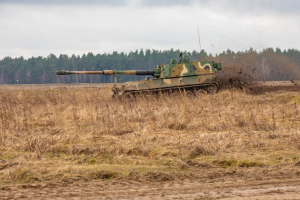The crisis in Ukraine has obligated Poland, as a NATO member, to fulfill moral duties to counter Russian aggression by providing assistance. In this case, assistance means more than money – a total of over 300 tanks have already been dispatched to Ukraine. Warsaw must replenish this equipment, as the urgency surrounding the issue of armaments in Poland has become critical.
To that end, Poland has recently entered into substantial agreements for the acquisition of military equipment from South Korea, amounting to an impressive $14.7 billion in new orders for the year 2022 alone. This development signifies that Poland will predominantly rely on South Korean weaponry moving forward. Why is Poland going to rebuild its armed forces with South Korea as a primary partner?
The initial factor is the promptness of delivery. South Korea demonstrated its efficiency by swiftly supplying Poland. An additional benefit lies in South Korea’s ability to procure necessary supplies. The South Korean defense industry maintains robust and secure relationships with its suppliers, such as semiconductor, spare parts, and engine manufacturers. The advantage of possessing an extensive industrial base is the facilitated accessibility to diverse components and provisions.
The second rationale lies in the element of flexibility. South Korea exhibits adaptability in authorizing the overseas production of its armaments through licensing. Unlike the United States, which adopts a stringent stance on allowing external production, South Korea is notably more accommodating.
Flexibility and expeditious delivery already provide compelling grounds for nations like Poland to choose South Korea as an arms supplier. The attractive cost of South Korean products is another major incentive. Take artillery as an example. While a French CAESAR commands a price of approximately $7.5 million and the German PzH 2000 can cost more than $10 million, the South Korean K9 Thunder is priced at less than $4 million. This notable cost advantage underscores the attractiveness of South Korean armaments in the global market.
South Korea’s defense industry is advantaged by its considerable production capabilities. Its ongoing efforts aim at achieving extended range and heightened accuracy in targeting North Korean threats. Germany presents a contrasting scenario, as the German military grapples with the repercussions of prolonged disinvestment. The military-industrial sector in Germany faces a challenge due to a diminished reliability, making it more arduous to sustain production at competitive prices.
The last consideration pertains to the quality of South Korean weaponry, marked by a process of modernization that has elevated it to levels of sophistication and complexity comparable to some of the finest U.S. armaments. A notable example of this advancement is the K-239 Chunmoo multiple rocket launcher system, acknowledged by military experts as closely resembling the U.S. HIMARS. The South Korean variant is approximately 40 percent more cost-effective than its U.S. counterpart.
Importantly for NATO members like Poland, compatibility with U.S. or NATO systems is not an issue. Integrating South Korean weapons is relatively easy because they adhere to NATO standards. South Korean arms manufacturers like Hanwha, Korea Aerospace Industries, and Hyundai Rotem offer systems designed for joint operations with U.S. forces, making them easy to integrate with NATO. Additionally, South Korea has been actively participating in NATO meetings, cooperating on various security challenges, arms control, and interoperability initiatives, which further aligns its weapons systems with NATO standards.
South Korea’s defense industry extends beyond ground armaments to naval and air force equipment. The Ministry of Defense of Indonesia inked a billion-dollar deal with Daewoo Shipbuilding and Marine Engineering for three diesel submarines. South Korea’s shipyards, exemplified by Hyundai Heavy Industries, also delivered the BRP Jose Rizal missile frigate to the Philippines and refurbished a Pohang-class corvette for Egypt, showcasing quality and global reach.
In the air domain, South Korea exported the KAI T-50 Golden Eagle to Indonesia, Thailand, and Iraq, offering cost-effective solutions for air force modernization. The KF-X program, a 4.5-generation multi-role fighter in development, has already attracted some potential buyers, indicating the jet’s international appeal due to its affordability compared to competitors like the Dassault Rafale or Eurofighter Typhoon. South Korea aims to produce 40 units by 2028 and 120 units by 2032, with prospects for sales to the Philippines, Thailand, Malaysia, Peru, Qatar, and Senegal.
The ongoing conflict in Ukraine, coupled with the turmoil in the Middle East and the escalating tensions in the Indo-Pacific, has led to a surge in military equipment demand while supply remains constrained. The supply chains for defense and security needs have also been disrupted, with no indications of a de-escalation in the geopolitical situation.
South Korea possesses a competitive edge in providing economically efficient military solutions without sacrificing quality. South Korea’s defense sector capitalizes on a proficient workforce and streamlined production methods, enabling it to present pricing that competes favorably with traditional suppliers. Importantly, the competitive price factor is especially attractive to countries facing budgetary limitations while aspiring to acquire contemporary military capabilities.
































